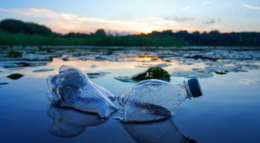
What the VOC is running into rivers?
Healthy freshwater is fundamental to all life on earth. Humans and the planet alike depend on an adequate supply of fresh, clean water. However, the UK's freshwater ecosystems are currently in a critical condition.
The poor state of many waterbodies in the UK is down to a complex and interconnected range of pollution sources including, amongst other issues: sewage discharge, agricultural run-off and road run-off.
Across our road networks, surface water runoff washes into the surrounding landscape every time it rains. Roadway runoff is mostly connected to storm sewers or combined sewers through millions of storm drains. These drains are not commonly connected to the sewage system and as a result road run-off is discharged directly into freshwater environments without treatment. Road run-off contains pollutants such as litter, animal excrement and tyre particulate matter.
Tyre-wear pollution is a very serious and growing environmental problem, exacerbated by the popularity of large, heavy passenger vehicles and the increasing number of heavy goods vehicles on the roads. Despite experts from Imperial College London calling for more to be done to limit the potentially harmful impact of toxic tyre particles on health and the environment, this pollution is completely unregulated.
Indeed, although there is some understanding of the presence and toxicity of tyre-wear pollution, there are limited data on pollutant concentrations and impacts. A recent report launched by Stormwater Shepherds and CIWEM identified several pollutants – including Copper, Zinc, Cadmium, fluoranthene, pyrene and polyaromatic hydrocarbons (PAHs) – present at concentrations which would fail Environmental Quality Standards. But with hundreds, if not thousands of chemicals present in tyres, and millions of storm drains across the UK, getting enough boots on the ground to properly assess tyre-wear pollution is a huge challenge.
This is where citizen science comes in. Defined as the active involvement of non-scientists in the scientific research process, citizen science is a powerful tool that can be used to combat the water pollution crisis. In Earthwatch Europe’s latest Great UK WaterBlitz, an incredible 4,500 citizen scientists assessed nutrient pollution across 2,300 freshwater sites over a four-day period, building a national picture of freshwater quality that simply couldn’t be captured by scientists for official monitoring bodies.

In an additional pilot study, conducted in collaboration with Emissions Analytics, Earthwatch Europe’s citizen scientists collected samples of water from puddles on roads, water running from roads into rivers, and from rivers directly, to test for the presence of Volatile organic compounds (VOCs). Antioxidants, stabilizers and rubber compounds, indicative of tyre pollution, were found in 100% of samples collected; some of them at concentrations higher than their predicted no-effect concentration (PNEC); suggesting these chemicals could be harming aquatic life.
With the wetter winter weather drawing in, road run-off and its associated tyre-wear pollution will become a more pressing issue. In early 2025, concerned citizen scientists in the Evenlode Catchment will be systematically investigating the presence of these VOCs; tracking their movement from roads, to outfalls and down the river Evenlode, creating a chemical heatmap to pinpoint the most problematic outfalls.
If, as we suspect, tyre particulates are entering our freshwater systems in significant concentrations, then we will need to look at ways of fixing the problem. Nature-based solutions, such as retention basins (constructed ponds with vegetation around the perimeter of a pool of water), detention basins (a structure into which stormwater runoff is directed, held for a period, and slowly drained to a surface water body) and constructed wetlands (a man-made basin that contains slowly-moving surface water, organic materials as well as water-tolerant plants, and organisms similar to those found in natural wetlands) can all trap suspended particles in road run-off and improve water quality; which can be evidenced through citizen science.
Ultimately, Earthwatch Europe wants to see accountability from all types of polluters: from agriculture, sewage overflows and urban run-off. With mounting evidence, we urge the Environment Agency and Highway Agency to take tyre particulate matter more seriously; for authorities to integrate citizen science into their freshwater monitoring frameworks; and for citizen scientists to continue monitoring and advocating for a healthy freshwater future.

Dr Sasha Woods is the Director of Science and Policy at environmental charity Earthwatch Europe. She leads the Science and Policy team at Earthwatch, ensuring the organisation’s work is scientifically rigorous and solutions focused.













